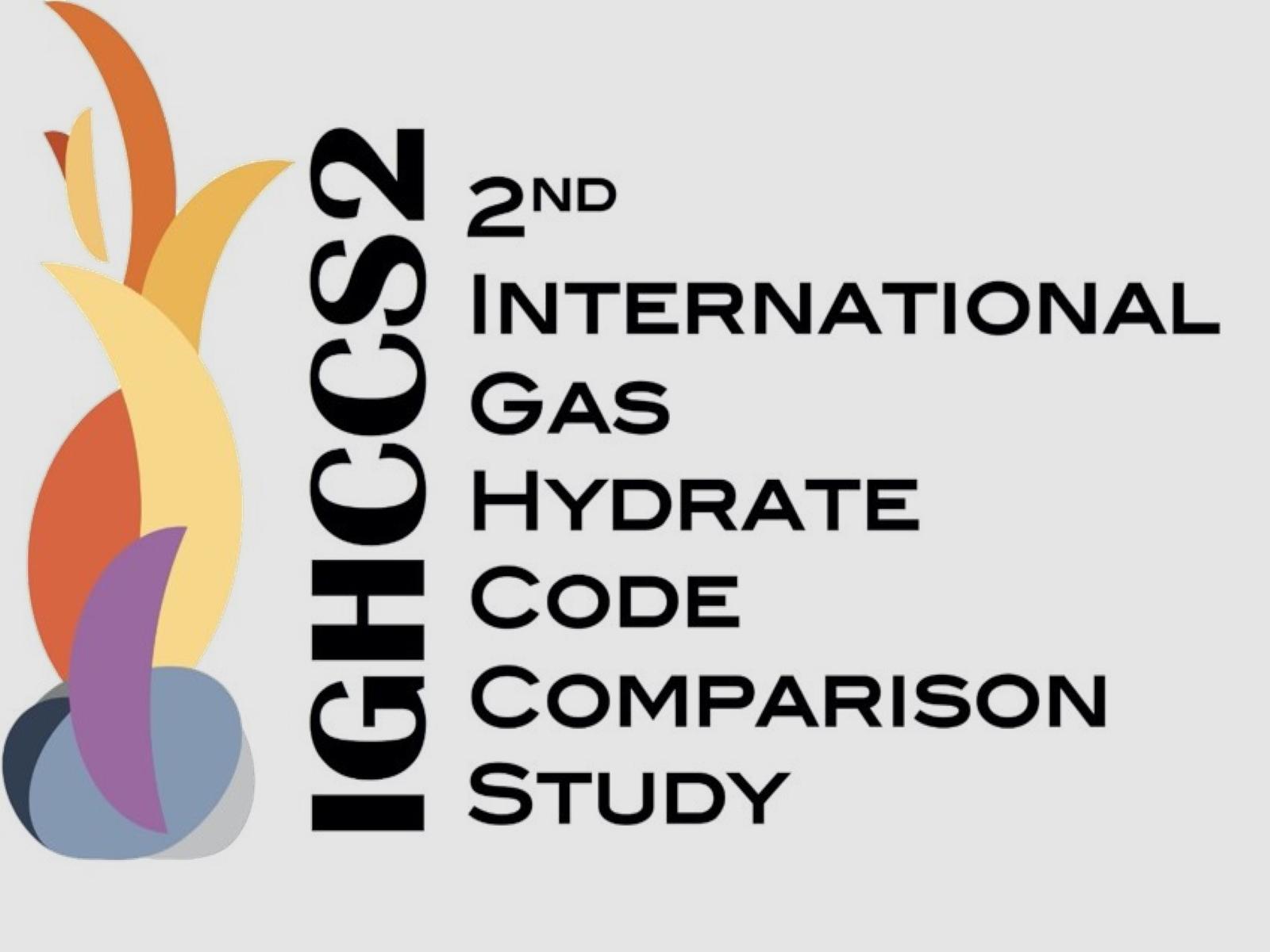International Study on Methane Hydrate Reservoirs
Modeling gas hydrate improves accuracy and reliability of natural gas

The International Gas Hydrate Code Comparison Study logo is based on “fire in the ice,” a photo by Bill Lawson.
(Logo by Mark White | Pacific Northwest National Laboratory)
The science
Natural gas represents a potential long-term energy source for the United States, with an estimated 53.8 trillion cubic feet of recoverable gas from hydrate deposits on the Alaska North Slope over the next 35 years. Realizing this resource is technically challenging, however, because simulations related to geomechanical processes for natural gas have historically been ignored.
Researchers at Pacific Northwest National Laboratory (PNNL) are part of an international team working to develop a technology that can produce gas hydrates in an economical, sustainable manner over the next 25 to 50 years.
This second International Gas Hydrate Code Comparison Study—IGHCCS2—demonstrates a significant improvement in the accuracy and reliability of modeling gas hydrate for the discovery and production of natural gas.
IGHCCS2 brought international experts together to compare their numerical tools to provide best estimates of geomechanical behavior of gas-hydrate-bearing reservoirs. These tools were used to evaluate simple and complex reservoir models whose behavior cannot be easily estimated or verified. Researchers from around the world used numerical simulators to identify and solve computer code problems, demonstrating a significant improvement in the accuracy and reliability of modeling gas hydrate reservoirs for the production of natural gas.
The three-year study provides a foundation for current and future gas hydrate reservoir simulators (GHRSs), a benchmark for the next generation of code development, and will inform design decisions based on simulations. By comparing the codes, problems can be easily identified and used to enhance geomechanical capabilities for real-world applications.
Before this study, GHRSs were being developed and applied to field problems involving coupled thermal, hydrologic, and geomechanical processes, but without having been verified or compared against other state-of-the-art computer codes. This study forms the foundation for current and future GHRSs to include geomechanical effects with confidence. Geomechanical processes, which significantly affect the response of gas hydrate reservoirs, have been historically ignored in simulations.
Simulating builds confidence in natural gas reservoirs
Natural gas requires a large investment in time and capital. Assurances are needed to demonstrate that enough methane can be extracted, and that production facilities can operate safely, over the reservoir’s lifetime.
GHRSs provide these assurances by forecasting long-term production rates of gas and water from methane gas hydrate reservoirs. The simulators also predict the reservoir’s mechanical behavior to establish design requirements for production systems capable of operating for the projected duration of operations.
Geologic reservoirs containing gas hydrates occur beneath permafrost environments and within marine continental slope sediments—representing a potentially vast natural gas source.
Numerical simulators provide scientists and engineers with tools for understanding how production efficiency depends on the numerous, interdependent processes associated with potential production strategies for these gas hydrate reservoirs. Successful comparisons of laboratory and field test results encourage confidence in the modeling and forecasting abilities of these GHRSs, but such results are rare, particularly in natural settings.
The hydrate community recognized another approach to building confidence in the GHRS—comparing simulation results between independently developed and executed computer codes on structured problems specifically tailored to the interdependent processes relevant for gas-hydrate-bearing systems.
In response, the National Energy Technology Laboratory (NETL) sponsored IGHCCS2. Co-led with PNNL and Lawrence Berkeley National Laboratory (LBNL), the study focused on coupled thermal, hydrologic, and geomechanical processes. IGHCCS2 included participants from 17 universities, research institutes, industry partners, national laboratories, and national geologic surveys. The resulting article, “An international code comparison study on coupled thermal, hydrologic and geomechanical processes of natural gas hydrate-bearing sediments,” was published in the October 2020 edition of Marine and Petroleum Geology (DOI: 10.1016/j.marpetgeo.2020.104566).
Impact
Participants developed five benchmark problems involving gas hydrate processes with geomechanical components. The problems included simple geometries, some with analytical solutions, from a representation of the world's first offshore test production of methane hydrates, which was conducted using the depressurization method off the coast of Japan. To identify strengths and limitations in the various GHRSs, study participants submitted solutions for the benchmark problems and discussed differing results via teleconferences.
The IGHCCS2 problem solutions are available here.
The five benchmark problems developed and solved in the study have established a standard against which new simulators can be verified and a knowledge base for developing and testing GHRSs. In early 2013, the world’s first production test attempt for marine gas hydrate deposits occurred in Eastern Nankai Trough, Japan. The test demonstrated the importance of geomechanics in depressurizing a gas hydrate reservoir, and IGHCCS2 reflects this importance by verifying this coupling in the world’s gas hydrate simulators.
Partners
PNNL partnered with DOE, LBNL, NETL, Woods Hole Coastal and Marine Science Center, Rensselaer Polytechnic Institute, University of Pittsburgh, GEOMAR Helmholtz Center for Ocean Research Kiel, and Kyoto University.
Authors
Mark White (PNNL); Timothy Kneafsey, Mathew Reagan, and Alejandro Queiruga (LBNL); Yongkoo Seol, Evgeniy Myshakin, and Xuerui Gai (NETL); William Waite (Woods Hole); Shun Uchida (Rensselaer); Jeen Lin (University of Pittsburgh); Shubhangi Gupta (GEOMAR); and Sayuri Kimoto (Kyoto University).
Next steps
This study provides a benchmark for the next generation of code development and will inform design decisions based on simulations. By comparing the codes, problems can be easily identified and used to enhance geomechanical capabilities for real-world applications. The study’s results will be utilized in future testing on the Alaska North Slope as more wells are drilled for depressurization.
Funding
This research is supported by the U.S. Department of Energy, Office of Fossil Energy, Office of Natural Gas and Petroleum Technology, through the National Energy Technology Laboratory.
Published: December 16, 2020
M.D. White, et al., "An international code comparison study on coupled thermal, hydrologic and geomechanical processes of natural gas hydrate-bearing sediments." Marine and Petroleum Geology (2020). [DOI: 10.1016/j.marpetgeo.2020.104566]